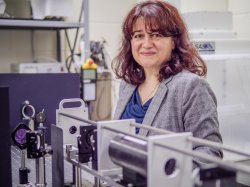Revealing the Secrets of the Universe
Professor receives NSF grant to help improve performance of future gravitational-wave detectors
Posted in: Research, Science and Technology, University

When black holes collide or neutron stars merge, they produce minute ripples in space-time that can be measured by gravitational-wave detectors. Since 2015, when the first gravitational wave from colliding black holes was measured by LIGO – the Laser Interferometer Gravitational-Wave Observatory – four more black hole collisions have been detected, as well as a binary neutron star merger. The significance of these discoveries, which confirmed century-old predictions made by Albert Einstein, were acknowledged by the 2017 Nobel Prize in Physics.
Rodica Martin, a professor in the newly launched Department of Physics and Astronomy, is a member of the LIGO team. She has recently received a $90,000 National Science Foundation grant to study the optical properties of materials that can be used to develop the next generation of gravitational-wave detectors.
“This grant will allow me to deepen my studies in new areas that contribute to increasing the sensitivity of future detectors,” Martin says. “With more sensitive instruments, LIGO can detect gravitational waves from sources that are much further away, or that are too weak to observe with current detectors, giving us new insights on the dynamics of the cosmos.”
Martin’s research will focus on exploring new magneto-optical materials for the detectors’ Faraday isolators. “Faraday isolators are key devices in providing optical isolation for the LIGO interferometers by redirecting unwanted back reflections and preventing them from altering the sensitivity of the detectors,” she explains.
By conducting tabletop optics experiments, she plans to measure the effectiveness of a range of materials at wavelengths above the current operation of LIGO and at cryogenic temperatures. This early identification of suitable materials for future Faraday isolators will support the development of gravitational-wave detectors that would be able to observe nearly all the stellar-mass black hole mergers in the universe – and facilitate even more precise tests of Einstein’s theory of relativity.
While the grant provides summer research and travel support for two students during the course of the three-year project, it will also give Montclair State undergraduate and graduate students the opportunity to develop hands-on skills in areas such as optics and lasers, spectroscopy, vacuum systems and cryogenics. “I’m thrilled about the opportunity to involve students in cutting-edge research that is relevant for the development of third-generation gravitational-wave detectors,” says Martin.
